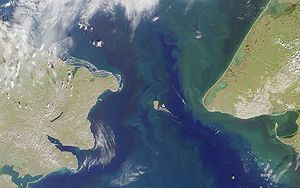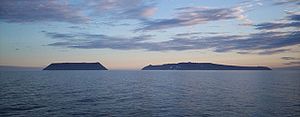Diomede Islands

The Diomede Islands (Russian: острова Диомида , ostrová Diomída), also known in Russia as Gvozdev Islands (Russian: острова Гвоздева, ostrová Gvozdjeva), consist of two rocky, tuya-like islands:
- The U.S. island of Little Diomede or in its native language, Ignaluk (it is also known as Krusenstern Island, though this may also refer to other places), and
- The Russian island of Big Diomede (part of Chukotka Autonomous Okrug), also known as Imaqliq, Inaliq, Nunarbuk or Ratmanov Island.
The Diomede Islands are located in the middle of the Bering Strait between mainland Alaska and Siberia, with the Chukchi Sea to the north and the Bering Sea to the south. 9.3 mi (15 km) to the southeast is Fairway Rock, which is generally not considered part of the Diomede Islands. The islands are sometimes called Tomorrow Island (Big Diomede) and Yesterday Isle (Little Diomede) because the time in Big Diomede is 20 hours (approximately a day) ahead of Little Diomede.
Contents |
Location

The islands are separated by an international border as well as the International Date Line which is approximately 1 km (0.6 mi) from each island. At the closest distance between Little Diomede and Big Diomede, the two islands are about 3.8 km (2.4 mi) apart. The small habitation on Little Diomede Island is centered to the west side of the island at the village of Diomede.
The Big Diomede Island is considered the easternmost point of Russia.
In April 2007 students on Little Diomede made a QuickTime VR Panorama. The QTVR files show both the US and Russian islands quite clearly, with the International Date Line tracing an invisible line on the ice between them.
The Diomede Islands are often mentioned as likely intermediate stops for a bridge or tunnel (Bering Strait bridge) spanning the Bering Strait.
History
The first European to reach the Bering Strait was the Russian explorer Semyon Dezhnev in 1648. He reported two islands whose natives had bone lip ornaments, but it is not certain that these were the Diomedes. A Danish navigator (in Russian service) Vitus Bering re-discovered the Diomede Islands on August 16, 1728, the day when the Russian Orthodox Church celebrates the memory of the martyr St. Diomede (hence, the name of the islands). In 1732, a Russian geodesist, Mikhail Gvozdev, plotted the islands on the map (hence, another name).
The text of the 1867 treaty finalizing the sale of Alaska uses the islands to designate the boundary between the two nations: The border separates "equidistantly Krusenstern Island, or Ignaluk, from Ratmanov Island, or Nunarbuk, and heads northward infinitely until it disappears completely in the Arctic Ocean."
During the Cold War, that gap constituted the border between the USA and the USSR, and became known as the "Ice Curtain". In 1987, however, Lynne Cox swam from one island to the other, and was congratulated by Mikhail Gorbachev and Ronald Reagan.
In summer 1995, British television actor and documentary presenter Michael Palin started his clockwise circumnavigation of the Pacific Rim, encompassing 18 different countries, on Little Diomede Island, as part of the BBC series Full Circle. He intended to set foot on it again at the very end of his journey lasting nearly eight months, but was unable to do so because he was returning during the following winter (on the U.S. Coast Guard Cutter Munro), and the sea became too rough to allow him and his film crew to land on the island.
Big Diomede Island was traditionally the easternmost landmass before the International Date Line, and the first landmass to ring in a new year, if using local solar time. When using official time, a large area in eastern Russia, as well as New Zealand, shares the same time zone. New Zealand also has Daylight Saving time in effect during late December, but Russia does not (see time in New Zealand and time in Russia). Starting in 1995 however, the IDL was moved to the east of Kiribati and that country's easternmost time zone (GMT+14) is now the world's earliest.
The native population of Big Diomede Island was relocated by the Soviet government to mainland Russia and the island is currently home to a small Russian military presence.[1] Little Diomede has an Inupiat Inuit population of 170,[2] mostly in the city of Diomede. This village has a school and a store. Some Inuit residents are famous for their ivory carving. Passenger travel and mail delivery is by helicopter, weather permitting.
References
External links
- Images of the islands
- Little Diomede page, with images
- Proposed Trans-Global Highway and AmerAsian Peace Tunnel
- Images of the islands
- Michael Palin site about Diomedes
- Dateliner Webcam: vantage of Big Diomede from Little Diomede
- CNN investigates Sarah Palin's claim of being able to see Russia from Alaska
|
|||||
|
|||||